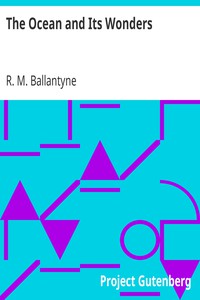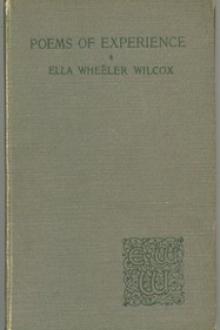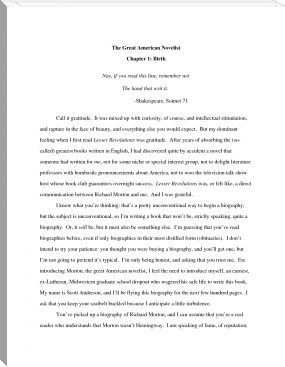The Ocean and Its Wonders by R. M. Ballantyne (free novel reading sites .TXT) 📖

- Author: R. M. Ballantyne
Book online «The Ocean and Its Wonders by R. M. Ballantyne (free novel reading sites .TXT) 📖». Author R. M. Ballantyne
But far other intentions are in the breast of Him who rides upon the storm. His object is to restore, not to destroy—to gladden, not to terrify. This tempestuous weather lasts for some days, but at the end of that time the change that comes over the face of nature seems little short of miraculous. In the words of Mr Elphinstone, who describes from personal observation—“The whole earth is covered with a sudden but luxuriant verdure, the rivers are full and tranquil, the air is pure and delicious, and the sky is varied and embellished with clouds.
“The effect of this change is visible on all the animal creation, and can only be imagined in Europe by supposing the depth of a dreary winter to start at once into all the freshness and brilliancy of spring. From that time the rain falls at intervals for about a month, when it comes on again with great violence; and in July the rains are at their height. During the third month they rather diminish, but are still heavy. In September they gradually abate, and are often suspended till near the end of the month, when they depart amid thunders and tempests, as they came.”
Such are the effects of the monsoons upon land and sea. Of course the terrific gales that usher them in and out could not be expected to pass without doing a good deal of damage, especially to shipping. But this is more than compensated by the facilities which they afford to navigation.
In many parts of the world, especially in the Indian Ocean, merchants calculate with certainty on these periodical winds. They despatch their ships with, say, the north-east monsoon, transact business in distant lands, and receive them back, laden with foreign produce, by the south-west monsoon. If there were no monsoons, the voyage from Canton to England could not be accomplished in nearly so short a time as it is at present.
And now as to the cause of monsoons. They are, for the most part, deflected trade-winds. And they owe their deflection to the presence of large continents. If there were no land near the equator, the trade-winds would always blow in the same manner right round the world; but the great continents, with their intensely-heated surfaces, cause local disturbance of the trade-winds. When a trade-wind is turned out of its course, it is regarded as a monsoon. For instance, the summer sun, beating on the interior plains of Asia, creates such intense heat in the atmosphere that it is more than sufficient to neutralise the forces which cause the trade-winds to blow. They are, accordingly, arrested and turned back. The great general law of the trades is in this region temporarily suspended, and the monsoons are created.
It is thus that the heated plains of Africa and Central America produce the monsoons of the Atlantic, the Pacific, and the Gulf of Mexico.
We think it unnecessary to explain minutely the causes that produce variation in the monsoons. Every intelligent reader will readily conceive how the change of seasons and varied configuration as well as unequal arrangement of land and water, will reverse, alter, and modify the direction and strength of the monsoons.
Land and sea breezes are the next species of wind to which we would direct attention. They occur in tropical countries, and owe their existence to the fact that the land is much more easily affected by sudden changes of temperature than the sea. Thus, the land in warm regions is much heated by the sun’s rays during the day; the atmosphere over it becomes also heated, in virtue of which it rises: the cool atmosphere over the sea rushes in to supply its place, and forms the sea breeze: which occurs only during the day.
At night the converse of this takes place. Land heats and cools rapidly; water heats and cools slowly. After the sun sets, the cooling of the land goes on faster than that of the sea. In a short time the atmosphere over the land becomes cooler than that over the sea; it descends and flows off out to sea; thus forming the land breeze. It occurs only at night, and when the change from one to the other is taking place there is always a short period of calm. Land and sea breezes are of the greatest use in refreshing those regions which, without them, would be almost, if not altogether, uninhabitable.
In “The Tempest,” an interesting work on the origin and phenomena of wind, published by the Society for Promoting Christian Knowledge, a curious and simple experiment is described, whereby the existence of upper and under currents of air and the action of land and sea breezes may be clearly seen and understood. We quote the passage:—
“The existence of the upper and under currents of air which mark the phenomena of the trade-winds, and of land and sea breezes, may be beautifully illustrated in two adjoining rooms, in one of which a good fire is burning, while in the other there is none. If the door between the two rooms be thrown open, the cold air will enter the heated room in a strong current, or, in other words, as a violent wind. At the same time the heated air of the warm room ascends and passes the contrary way into the cold room, at the upper part of the same doorway; while in the middle of this opening, exactly between the two currents, the air appears to have little or no motion. The best way to show this experiment is to introduce the flame of a candle into the doorway between a hot and a cold room. If the flame be held near the bottom of the doorway, where the air is most dense, it will be strongly drawn towards the heated room; and if held near the top of the door it will be drawn towards the cold room with somewhat less force; while midway between the top and bottom the flame will be scarcely disturbed.
“There is also another pretty experiment which illustrates well the theory of land and sea breezes. Take a large dish, fill it with cold water, and in the middle of this put a water-plate or a saucer filled with warm water. The first will represent the ocean, and the latter an island made hot by the rays of the sun, and rarefying the air above it. Take a lighted wax candle and blow it out; and, if the air of the room be still, on applying it successively to every side of the saucer, the smoke will be seen moving towards the saucer and rising over it, thus indicating the course of the air from sea to land. On reversing the experiment, by filling the saucer with cold water (to represent the island at night) and the dish with warm water, the land breeze will be shown by holding the smoking wick over the edge of the saucer; the smoke will then be wafted to the warmer air over the dish.”
We have just tried the first of these experiments, with complete success. We would, however, recommend a piece of twisted brown paper, lighted and blown out, instead of a wax candle, because it gives out more smoke and is probably more obtainable on short notice. The experiment of the doorway, moreover, does not require that there should lie two rooms with a door between. We have found that the door of our study, which opens into a cold passage, serves the purpose admirably.
Were we treating chiefly of the atmosphere in this work, it would be necessary that we should enlarge on all the varieties of winds, with their causes, effects, and numerous modifications. But our main subject is the Ocean. The atmosphere, although it could not with justice have been altogether passed over, must hold a secondary place here; therefore we will conclude our remarks on it with a brief reference to hurricanes.
It has been ascertained that most of the great storms that sweep with devastating fury over the land and sea are not, as was supposed, rectilinear in their motion, but circular. They are, in fact, enormous whirlwinds, sometimes upwards of one hundred and fifty miles in diameter; and they not only whirl round their own centres, but advance steadily forward through space.
In the year 1831, a memorable and dreadful series of storms passed over some of the India Islands, and caused terrible havoc, especially in the island of Barbadoes. The peculiarity of these hurricanes was that they ravaged the different islands at different dates, and were therefore supposed to be different storms. Such, however, was not the case. It was one mighty cyclone, or circular storm,—a gigantic whirlwind,—which traversed that region at the rate of about sixteen miles an hour. It was not its progressive, but its rotatory motion, that constituted its terrible power. On the 10th of August it reached Barbadoes; on the 11th, the islands of Saint Vincent and Saint Lucia; on the 12th it touched the southern coast of Porto Rico; on the 13th it swept over part of Cuba; on the 14th it encountered Havanna; on the 17th it reached the northern shores of the Gulf of Mexico and travelled on to New Orleans, where it raged till the 18th. It thus, in six days, passed, as a whirlwind of destruction, over two thousand three hundred miles of land and sea. It was finally dissipated amid heavy rains.
The effect of a hurricane is well described by Washington Irving. “About mid-day,” he says, “a furious gale sprang up from the east, driving before it dense volumes of cloud and vapour. Encountering another tempest from the west, it appeared as if a violent conflict ensued. The clouds were rent by incessant flashes, or rather streams, of lightning. At one time they were piled up high in the sky, at another they descended to the earth, filling the air with a baleful darkness, more impenetrable than the obscurity of midnight. Wherever the hurricane passed, whole tracts of forest were shivered and stripped of their leaves and branches; and trees of gigantic size, which resisted the blast, were torn up by the roots and hurled to a great distance. Groves were torn from the mountain-precipices, and vast masses of earth and rock precipitated into the valleys with terrific noise, choking the course of the rivers.
“The fearful sounds in the air and on the earth, the pealing thunder, the vivid lightning, the howling of the wind, the crash of falling trees and rocks, filled every one with affright, and many thought that the end of the world was at hand. Some fled to caverns for safety, for their frail houses were blown down, and the air was filled with the trunks and branches of trees, and even with fragments of rocks, carried along by the fury of the tempest. When the hurricane reached the harbour, it whirled the ships round as they lay at anchor, snapped their cables, and sunk three of them to the bottom with all who were on board. Others were driven about, dashed against each other, and tossed mere wrecks upon the shore by the swelling surges of the sea, which in some places rolled for three or four miles upon the land. This tempest lasted for three hours.”
The China seas are the most frequently visited by severe tempests, or typhoons; yet of all vessels, the Chinese junks, as they are called, seem to be least adapted by their build for encountering such storms.
A terrible hurricane burst upon the China seas in the month of January 1837, as we learn from the “United Service Journal” of that year. An English vessel was exposed to
 Have you ever thought about what fiction is? Probably, such a question may seem surprising: and so everything is clear. Every person throughout his life has to repeatedly create the works he needs for specific purposes - statements, autobiographies, dictations - using not gypsum or clay, not musical notes, not paints, but just a word. At the same time, almost every person will be very surprised if he is told that he thereby created a work of fiction, which is very different from visual art, music and sculpture making. However, everyone understands that a student's essay or dictation is fundamentally different from novels, short stories, news that are created by professional writers. In the works of professionals there is the most important difference - excogitation. But, oddly enough, in a school literature course, you don’t realize the full power of fiction. So using our website in your free time discover fiction for yourself.
Have you ever thought about what fiction is? Probably, such a question may seem surprising: and so everything is clear. Every person throughout his life has to repeatedly create the works he needs for specific purposes - statements, autobiographies, dictations - using not gypsum or clay, not musical notes, not paints, but just a word. At the same time, almost every person will be very surprised if he is told that he thereby created a work of fiction, which is very different from visual art, music and sculpture making. However, everyone understands that a student's essay or dictation is fundamentally different from novels, short stories, news that are created by professional writers. In the works of professionals there is the most important difference - excogitation. But, oddly enough, in a school literature course, you don’t realize the full power of fiction. So using our website in your free time discover fiction for yourself. 




Comments (0)